
Nordland is one of the three northernmost counties in Norway in the Northern Norway region, bordering Troms in the north, Trøndelag in the south, Norrbotten County in Sweden to the east, Västerbotten County to the south-east, and the Atlantic Ocean to the west. The county was formerly known as Nordlandene amt. The county administration is in the town of Bodø. The remote Arctic island of Jan Mayen has been administered from Nordland since 1995. In the southern part of the county is Vega, listed on the UNESCO World Heritage Site list.

Alstahaug is a municipality in Nordland county, Norway. It is part of the Helgeland region. The administrative centre of the municipality is the town of Sandnessjøen. Some of the villages in Alstahaug include Søvika and Tjøtta.

Lurøy is a municipality in Nordland county, Norway. It is part of the Helgeland traditional region. The administrative centre of the municipality is located on the island of Onøya. Other villages in Lurøy include Aldra, Haugland, Konsvikosen, Lovund, Lurøy, Sleneset / Solværøyene, Stokkvågen, and Tonnes.
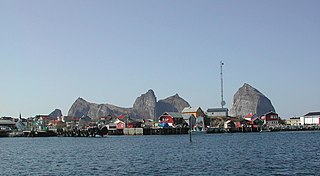
Træna is a municipality in Nordland county, Norway. It is part of the Helgeland traditional region. The administrative centre of the municipality is the island/village of Husøya. Other population centres include Selvær and Sanna.

Rødøy is a municipality in Nordland county, Norway. It is part of the Helgeland traditional region. The administrative centre of the municipality is the village of Vågaholmen. Other villages include Gjerøy, Jektvika, Kilboghamn, Melfjordbotn, Oldervika, Sørfjorden, and Tjong. The municipality consists of many islands to the west of Norway's second biggest glacier, Svartisen.

Sandnessjøen is a town and the administrative centre of Alstahaug Municipality in Nordland county, Norway. Sandnessjøen was granted special trading privileges in the late 1600s and it received town status in 1999. Sandnessjøen is located on the island of Alsta, just west of the De syv søstre mountain range.
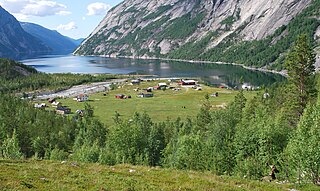
Northern Norway is a geographical region of Norway, consisting of the three northernmost counties Nordland, Troms and Finnmark, in total about 35% of the Norwegian mainland. Some of the largest towns in Northern Norway are Mo i Rana, Bodø, Narvik, Harstad, Tromsø and Alta. Northern Norway is often described as the land of the midnight sun and the land of the northern lights. Farther north, halfway to the North Pole, is the Arctic archipelago of Svalbard, traditionally not regarded as part of Northern Norway.
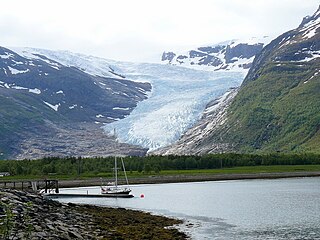
Svartisen is a collective term for two glaciers located in Nordland county in northern Norway. It is part of Saltfjellet-Svartisen National Park, located in the Saltfjell mountain range. The glaciers are located in the municipalities of Beiarn, Meløy, Rana, and Rødøy. Svartisen consists of two separate glaciers that are separated by the 1-kilometre (0.62 mi) long Vesterdalen valley. The two glaciers are:

Saltfjellet–Svartisen National Park is a national park in Nordland county in Norway. It is located within the municipalities of Beiarn, Meløy, Rana, Rødøy, Saltdal, and Bodø. The European route E6 highway and the Nordland Line railway both follow the southern and eastern borders around the park. The park's eastern border is the Norway-Sweden border and a portion of this border is shared with the Vindelfjällen Nature Reserve which lies in Sweden.

Saltfjellet is a mountain area in Nordland county, Norway that separates the two regions of Helgeland and Salten. It is also a cultural border between the Southern and Central parts of Sápmi.

Lovund Church is a chapel of the Church of Norway in Lurøy Municipality in Nordland county, Norway. It is located in the island village of Lovund. It is an annex chapel in the Lurøy parish which is part of the Nord-Helgeland prosti (deanery) in the Diocese of Sør-Hålogaland. The white, wooden chapel was built in a long church style in 1960 using plans drawn up by the architects John Egil Tverdahl, Petter Andersen, and Harald Myrvang. The building was consecrated on 11 September 1960 by the Bishop Hans Edvard Wisløff.

Melfjorden is a fjord in Rødøy Municipality in Nordland county, Norway. It is located on the Arctic Circle. The 33-kilometre (21 mi) long fjord goes from the village of Melfjordbotn in the east to its mouth in the Rødøyfjorden near the island of Rangsundøya. There are two fjord arms that branch off the main fjord: Nordfjorden flows to the north into the Saltfjellet–Svartisen National Park and Sørfjorden to the south past the villages of Sørfjorden and Kilboghavn.
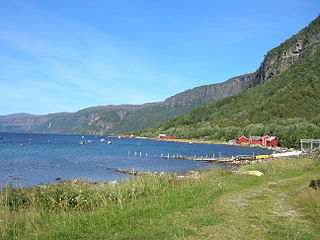
Melfjordbotn or Melfjorden is a village in Rødøy Municipality in Nordland county, Norway. The village is located at the eastern end of the Melfjorden, southwest of the Svartisen glacier. The Saltfjellet–Svartisen National Park lies about 7 kilometres (4.3 mi) north of the village.

Helgeland Kammerkor is a mixed choir from the region of Helgeland in Northern Norway. The choir was founded in Sandnessjøen i 1992, and currently has around 30 members. The members of Helgeland Kammerkor meet once a month for rehearsals, and give concerts 4-5 times a year. The choir has a broad repertoire that includes church music, madrigals, Nordic folk music and large concert works such as Carmina Burana by Carl Orff. From 2009 to 2018 the choir was conducted by Christopher Eva.

Alstahaug District Court was a district court in Nordland county, Norway. The court was based in the town of Sandnessjøen. The court existed from 1859 until 2021. It served the municipalities of Alstahaug, Dønna, Grane, Hattfjelldal, Herøy, Leirfjord, and Vefsn. Cases from this court could be appealed to Hålogaland Court of Appeal. The court was led by the chief judge Rolf Selfors, who also lead the neighboring Rana District Court and Brønnøy District Court at the time of the court's dissolution. This court employed a chief judge and three other judges.

Rana District Court was a district court in Nordland county, Norway. The court was based in the town of Mo i Rana. The court existed from 1859 until 2021. It served the central part of the county which included the municipalities of Rana, Hemnes, Nesna, Lurøy, Træna, and Rødøy. Cases from this court could be appealed to Hålogaland Court of Appeal. The court was led by the chief judge Rolf Selfors, who also lead the neighboring Alstahaug District Court and Brønnøy District Court at the time of the court's dissolution. This court employed a chief judge, two other judges, and two prosecutors.
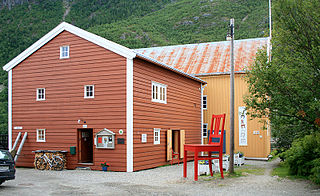
The Helgeland Museum is a group of 18 museums and collections of buildings in 18 municipalities in Helgeland, Norway. The concept of the museum is to distribute the museum's expertise across Helgeland. This allows people with special professional skills to work for all of the museums in this collaboration. The Helgeland Museum has about 49 permanent employees. Its administrative office is on Sjøgata in Mosjøen.
The Nordland Fotballkrets(Nordland Football Association) is one of the 18 district organisations of the Norwegian Football Federation. It administers lower tier football in the traditional district of Helgeland and Salten.

Helgeland District Court is a district court located in Nordland county, Norway. This court is based at three different courthouses which are located in Brønnøysund, Mo i Rana, and Sandnessjøen. The court serves the southern part of the county which includes cases from 17 municipalities. The court in Brønnøysund accepts cases from the municipalities of Bindal, Brønnøy, Sømna, Vega, and Vevelstad. The court in Mo i Rana accepts cases from the municipalities of Hemnes, Lurøy, Nesna, Rana, Rødøy, and Træna. The court in Sandnessjøen accepts cases from the municipalities of Alstahaug, Dønna, Grane, Hattfjelldal, Herøy, Leirfjord, and Vefsn. The court is subordinate to the Hålogaland Court of Appeal.



























